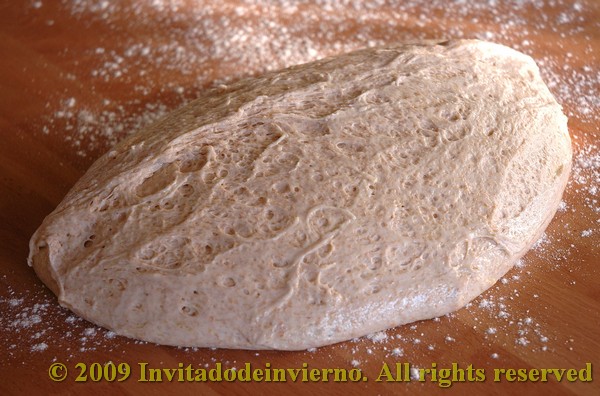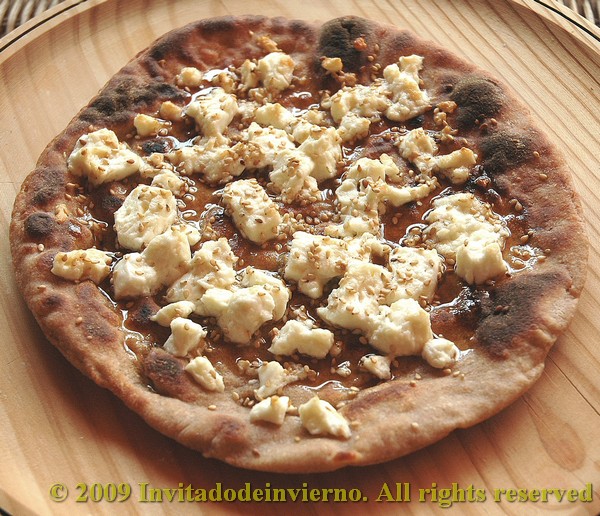Staititai or Ancient Roman pizza
>> Wednesday, September 23, 2009

Some time ago I bought a book about Ancient Roman cookery, called exactly Roman Cookery, by Mark Grant, who is a British classics teacher. It includes quite a lot of interesting recipes, but the most interesting thing to me was to realize how different Mediterranean cooking was before the discovery of America and the spreading in Europe of crops that we now feel so naturally Mediterranean like tomato, pepper and many more. Take pizza for example... think about it, without tomato? Well, no problem, that's white pizza. But the dough would be made with spelt instead of white wheat. And you'd have neither red nor green pepper to add for garnish. There's a very simple and delicious pizza-like recipe in this book, cooked on a skillet instead of baked, named Staititai, coming from a book called The partying professors, by the Greek writer Athenaeus. According to Mr. Grant, this Greek book would be widely known in Rome.
The recipe calls for baker's yeast, but I used sourdough instead, because anyway that's what the Romans would have used. I'm trying to be more authentic than the author...
Staititai from Roman Cookery (tweaked for sourdough)
Filling for one pizza (20cm wide)
Mix the sourdough with the flour and the water. Leave to autolyse for 15-20 minutes. Then knead around 10 minutes by hand or 7-8 minutes with a blender, until the gluten is developed. Place into an oiled bowl, turn the dough so that the oil covers all the surface, cover with a plastic shower cap and leave till double in bulk. Mine took quite long to double, at least 6 hours. Then tip the dough on the counter, make a neat roll and divide the roll in 5 pieces. These pieces make small pizzas, around 20cm diameter. You can change the size of the pieces if you like by dividing the dough in more pieces (or less). Remember the pieces must fit into a skillet.
At this point I wrapped 4 of the pieces in plastic and put them in the freezer for a rainy day. I left one to proof in my refrigerator overnight, to eat it the next day. I work at home and I eat alone (sounds like an existentialist rhyming couplet). The next day I took the dough out and left it to temper for half an hour. Then I rolled it with a rolling pin to a 20cm-disc, more or less. I put a skillet on low heat, sprinkled it with olive oil and lay the disc of dough. It started to puff up nicely. When the underside showed quite some browned spots, I brushed some oil on the upperside and turned the disc. I waited for the whole thing to brown and cook, it puffed in a similar way to a pita bread. Switch on the oven grill in the meantime.
Fine, now you have a nice browned bread base where you can put the cheese and sprinkle the sesame seeds. The recipe's direction is to add the honey at this point too, but I preferred to add it after grilling. Then put the base with the filling under a hot grill and let the cheese get soft for 5 minutes or so, to your taste. Remember that feta doesn't really melt. You'll start noticing the wonderful smell of the roasting sesame seeds. If you're anything like me, the aromas will make you feel like pouring yourself a glass of white wine... ahem (I did). When it is sufficiently grilled (keep an eye on it, otherwise the bread can brown excessively), take it out of the oven and drizzle with the honey while warm.
I must admit that I found the result stunning, much better than expected. I didn't think that such a simple combination of ingredients would make such a delicious dish. Trust me, the combination of the toasted sesame seeds with the cheese and the sweet touch of the honey makes a wonderful assembly! I could have eaten another one, no doubt. And this pizza cut in wedges and piping hot can make a very interesting appetizer... alongside some spiced olives... and a glass of wine... yes, I picture myself dressed in a tunic, sitting under a holm oak... overlooking some cliff by the sea... softly playing a lyre... don't you smell the Mediterranean? Wow, I get carried away!
This bread goes to Susan/Wild Yeast for this week's YeastSpotting.
















19 comentarios:
Mmm, I think I can imagine that taste of toasted sesame+feta+sweet honey... and it seems very interesting to me! Thank you for the recipe!..
I have never cooked with spelt, but this looks fantastic!
Oh my, this pizza looks amazing!
Oooh - I love the semi Middle Eastern flavours.... Looks delicious!
very interesting pizza recipe, I love the history of this pizza. it is always fascinating to read what the culinary trends were during ancient Roman times.
While ancient, it sort of has the ring of a more contemporary flatbread with the fusion of Italian and Mideastern flavors. To me, feta and honey is a natural pairing. Looks delicious.
Miriam, Absolutely beautiful! I do use spelt flour at home and for that reason, that it's one of the whole grains we used traditionally. I just wish I could bake like you! Have you checked out the book Nourishing Traditions? I really think you would enjoy it :) Miriam, what was the title of the bread book you had mentioned to me awhile back to get started? I'm going to buy it! It's the next move I've been wanting to make for some time now. I'm tired of preservative filled pan bimbo, haha! It's time to start eating bread like a true Spaniard!
Un abrazo fuerte!
Glad to know the ancients ate so well! Mangia :)
Wow, it looks very tasty!
Alessandro: thanks for visiting, I love historical cuisine too. And I find your work stunning!
Alina: thanks!
Miranda: you should try it! It's a healthier species than plain white wheat.
Simply Life: thanks!
Mardi: yep, the combination of flavors is awesome.
Jessie: thanks!
Joan: you're absolutely right!
Diana: I've heard about the Nourishing Traditions book, maybe I should consider to buy it. Regarding bread baking books, I advise you to buy "The bread baker's apprentice" by Peter Reinhart or "Crumb" by Richard Bertinet. And as for the Spaniards eating bread... well, the general quality of Spanish bread is steadily going down... but that would fill another post.
Rachel: they were ancient... but no fools! ;-)
Tania: thanks!
Sophie: I love spelt too and according to some sources, it's a lot healthier than normal white wheat.
I first heard of spelt on the daring cooks challenge.. I have never used it in baking or cooking but would love to try if I ever get my hands on it. BTW, your pizza looks yummy, I could eat the whole thing by myself..
Beautiful rustic looking pizza. Thanks for the sharing this recipe. And a very interesting post too.
If I can't find spelt. What can I use instead?
It looks like those professors definitely knew how to party. What a delicious combination of ingredients!
Olive: thanks!
Shwetha: of course you can substitute plain bread flour, only the pizza won't be so "ancient" :-)
Susan: sure they did! ;-)
We just went to a greek restaurant that offers an appetizer of fresh feta cheese drizzled in honey and sesame seeds!
These flat breads look awesome! thank you for converting them to sourdough (now I don't have to do the work! :0) )
Mimi: you see, that's what I like about Greek food, that it still uses the same ingredients... if they work, I should you change them?
This is a fascinating recipe for food history buffs, plus the use of spelt makes it healthier. A must on my list of recipes to try.
Epicure, I'm sure you'll like it!
I loved your sourdough pizza recipe!!1 AWesome dough - this is now my favorite! Thank you!!!
LeeYong
Post a Comment